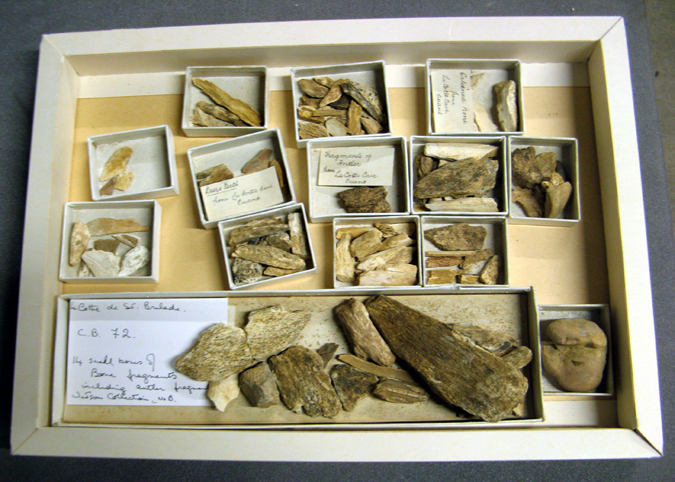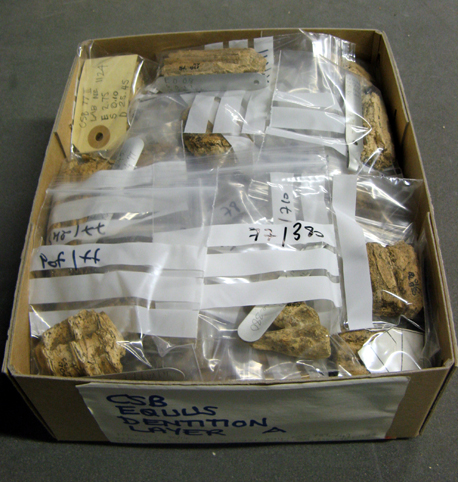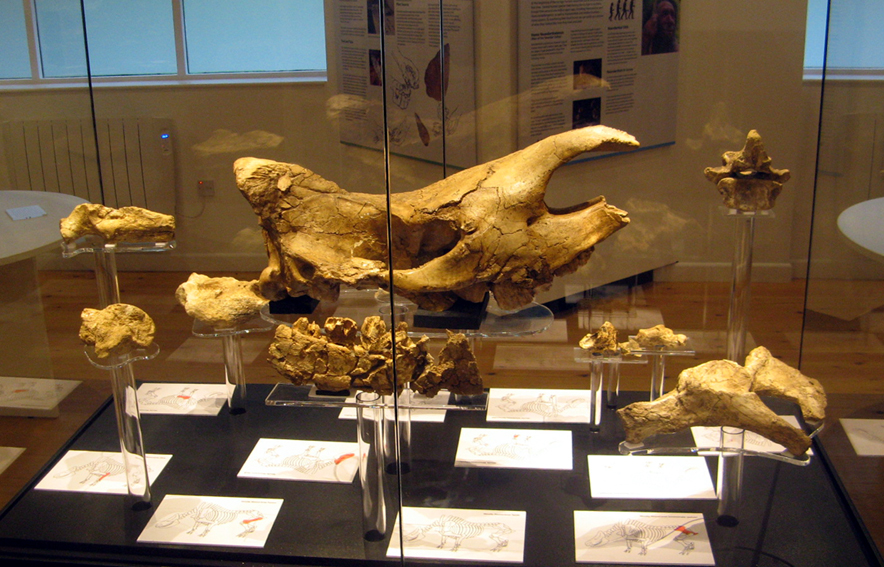 Nigel Larkin was recently asked by Jersey Heritage to assess the state of their collection of Ice Age fauna (Woolly Mammoths, Woolly Rhino etc)
from the famous site of La Cotte de St Brelade (this link is to a webpage on Wikipedia), 'one of the most important Neanderthal sites in North-West Europe' (this link is to a a Jersey Heritage webpage). This coastal site on Jersey, excavated in various phases over the last 100 years but primarily from 1961 to 1978 by
Cambridge University, is particularly famous for the piles of Woolly Mammoth bones found in loess deposits (wind-blown sands) in a ravine, presumably left behind by
the Neanderthals whose stone tools are found in their thousands around the site. There has been speculation that the Neanderthals ‘herded’ the Woolly Mammoths over the cliffs to their deaths, but other scenarios have been put forward as well. The bones were certainly left placed in organised piles.
Nigel Larkin was recently asked by Jersey Heritage to assess the state of their collection of Ice Age fauna (Woolly Mammoths, Woolly Rhino etc)
from the famous site of La Cotte de St Brelade (this link is to a webpage on Wikipedia), 'one of the most important Neanderthal sites in North-West Europe' (this link is to a a Jersey Heritage webpage). This coastal site on Jersey, excavated in various phases over the last 100 years but primarily from 1961 to 1978 by
Cambridge University, is particularly famous for the piles of Woolly Mammoth bones found in loess deposits (wind-blown sands) in a ravine, presumably left behind by
the Neanderthals whose stone tools are found in their thousands around the site. There has been speculation that the Neanderthals ‘herded’ the Woolly Mammoths over the cliffs to their deaths, but other scenarios have been put forward as well. The bones were certainly left placed in organised piles.
Since the excavations, the bones were thought to have deteriorated over the years and museum staff (working on the bones to the right) understandably wanted to know if this was correct, and if so why – and what could be done about it?
 Nigel spent three days assessing the state of hundreds of specimens. In addition, he looked at how the bones were stored (left and below) and how they were being handled, and analysed the records from the various excavations. A 23-page report of over 8,000 words was delivered by the end of the three days. This explained in some detail all the various conservation treatments the bones had undergone during the excavations and subsequently during off-site preparation, as well as listing the times of year the excavations took place and generally what the weather conditions were like at the time. Also, what the bones were like when originally found. The conflation of various factors meant that the very poorly preserved bones (often with great surface detail but the strength of cheese) needed to be well consolidated in the field before they were excavated and removed – but because the excavations took place in the early spring (when students were available) and the conditions were usually very cold and damp, the pore spaces of the bones were occupied with water and this allowed very little penetration of the consolidants used. This was compounded by the fact that the bones were very close together and frequently abutting the rock walls. The bones were brought of site very competently considering the logistics, but had never been subsequently re-consolidated enough to afford them the best protection over many ensuing decades.
Nigel spent three days assessing the state of hundreds of specimens. In addition, he looked at how the bones were stored (left and below) and how they were being handled, and analysed the records from the various excavations. A 23-page report of over 8,000 words was delivered by the end of the three days. This explained in some detail all the various conservation treatments the bones had undergone during the excavations and subsequently during off-site preparation, as well as listing the times of year the excavations took place and generally what the weather conditions were like at the time. Also, what the bones were like when originally found. The conflation of various factors meant that the very poorly preserved bones (often with great surface detail but the strength of cheese) needed to be well consolidated in the field before they were excavated and removed – but because the excavations took place in the early spring (when students were available) and the conditions were usually very cold and damp, the pore spaces of the bones were occupied with water and this allowed very little penetration of the consolidants used. This was compounded by the fact that the bones were very close together and frequently abutting the rock walls. The bones were brought of site very competently considering the logistics, but had never been subsequently re-consolidated enough to afford them the best protection over many ensuing decades.
The report concluded that not only were the bones understandably still extremely fragile and friable and required consolidation and in some cases repair plus some improvements in packaging, but how they were being handled and studied could be improved greatly to reduce handling and therefore reduce any potential for damage in the future. This is particularly important right now as the material is being re-anaylsed as part of a current research and fieldwork program on the island. See:
A new view from La Cotte de St Brelade, Jersey (a paper by Beccy Scott et al, 2104)
and
Matt Pope's talk at the British Museum 'At home with the Neanderthals: Excavations at La Cotte de St Brelade' on YouTube (51 minutes long).






Various specimens in storage


Woolly Rhino skull and other bones from the site on display.
For more details about what we can do for you, or for a quote, please
contact:
enquiries@natural-history-conservation.com
We
are members of ICON, the Institute of Conservation